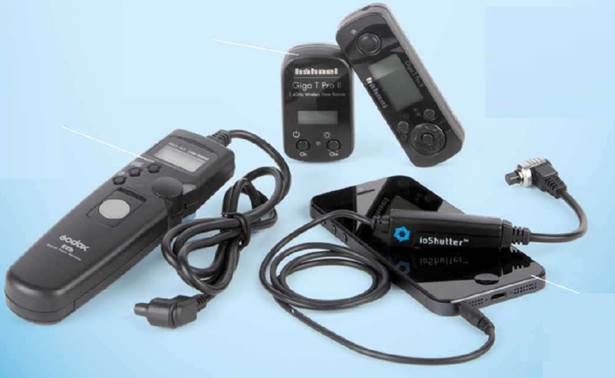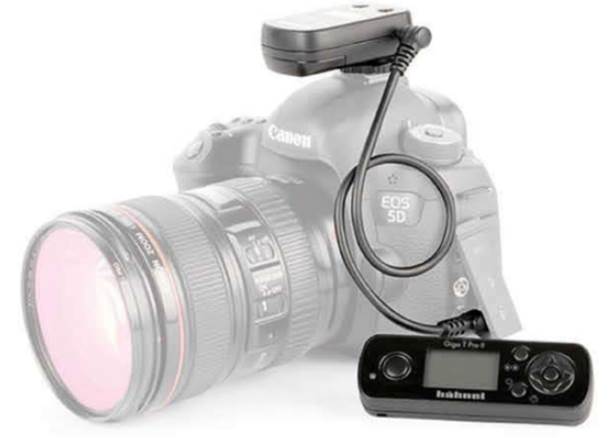Need a cable or remote release for your
DSLR? We reveal their uses and what’s available to you
One accessory you can guarantee won't be in
the box when you buy a camera is a cable or remote release. These are used to
trigger the camera in a different way rather than pressing the shutter button,
and there are an endless number of situations where you may want to take a shot
without having physical contact with the camera. Two examples are sports and
wildlife photography were photographers can often struggle to bag the shot they
want because of either restricted access, danger of disturbing their subject,
or risk of personal injury. Over the years camera triggering devices have
developed significantly and they’re more versatile and convenient to use than
ever before. If you’re undecided on what kind of release is the right solution
for your triggering needs, turn the page where we’ll discover the various types
available and explain what situations they’re best suited for.

Remote
Trigger (top) – Communicates to the camera wirelessly and instructs the camera
to fire the shutter; Cable release (left) – Attaches to the camera via a cable.
Some are more complex than others; Smartphone trigger (right) – works like a
cable release and features more modern functionality and control
When you’re looking at which triggering
device to buy, you have a decision to make. Do you choose a cable release or
opt for a wireless version instead? Cable releases trace their roots right back
to the early days of photography and, as the name suggests, they connect to the
camera via a cable by means of a screw-in or plug-in port. The length of the
cable plays a big part in how far away you can shoot from the camera and a
typical length is around 80-100cm, though on some versions there’s the option
to extend the length with an appropriate extension cable.

An
interval timer can be extremely useful when you want to capture a succession of
shots over a very long duration
Cheap cable releases don’t offer a huge
amount of functionality other than letting you shoot without disturbing the
camera setup or locking the shutter open for long exposures at night or in low
light. Spend a little more money on one and you’ll get a few extra buttons that
let you set up an interval timer or set up the self-timer. Some of the more
expensive cable releases also feature small LCD displays, giving you an
accurate reading of how long the shutter has been opened for or a countdown
timer indicating how many seconds remain before the camera’s shutter is fired.
They tend to be most commonly used in
situations when camera stability is vital in achieving a pin-sharp image, such
as when shooting a macro subject where the close magnification can emphasise
the tiniest movements of the camera. By locking off the camera on a tripod and
using a cable release you minimize virtually all risk of camera shake and
guarantee sharper shots as a result.
It’s not uncommon to see photographers
using cable releases when using telephoto lenses either and just like macro
work they can prevent the camera being moved or knocked accidentally. Cable
releases do have their limitations though. If you’d like to fire the shutter
from any great distance the length of the cable can restrict you can they don’t
allow you to work remotely.
Wireless releases
For those who don’t want any constraints, a
wireless remote release is the alternative. Featuring their own receiver and
transmitter units, infrared triggers were one of the first types to be made but
unfortunately these too have one key restraint. As they rely on line of sight,
anything that clocks the controller’s path of light to the camera can prevent
the shutter being triggered, making them unsuitable for some situations where
you can’t always align yourself perfectly with the camera. Wireless releases
that use the 2/4GHz radio frequency are more reliable. By looking for one that
offers different channels you’ll have the option to switch channel and avoid
interference from other photographers who may be close to you and using the
same triggering device.

If
you’d like to work remotely from your camera, a wireless remote trigger is the
best solution. A receiver attaches to the hotshoe and plugs into the camera’s
remote port with its own cable. The handheld trigger communicates with the
receiver by radio frequency and then fires the shutter
The radio receiver that connects to the
camera’s remote port should feature a hotshoe mount so it’s easy to attach to
the camera, and the wireless release transmitter will typically be designed
like a shutter button so when you half depress it the camera will autofocus and
by holding it down the shutter will fire. As well as being able to set the
camera to its drive mode or self-timer mode before triggering it with a wireless
release, more-advanced remote triggers will allow you to set these shooting
options directly from the transmitter.
Much like cable releases, the more you pay,
the more advanced features you can expect in return. Wireless releases such as
Hahnel’s Giga T Pro II remote ($95) feature a small LCD display so you can use
the controller as a stopwatch during long exposures and its backlight could
prove particularly useful when working remotely in the dark.
If you know that you’re going to be
shooting at long distances from the camera, the working range also plays a big
part in which wireless release you choose. A 100m range is average on most
wireless releases, though there are professional wireless triggers that enable
you to trigger a camera remotely from up to 50m away, without the need for
signal repeaters or daisy-chained radios. One example is PocketWizard’s
MultiMax transceiver, but this specialist wireless remote does come with a
hefty $372.5 price-tag.
Remote ports
Canon
A 3-pin remote port is found on most Canon
DSLRs and is located at the side.
Nikon
Many Nikon DSLRs, such as the D300, D700
and D800, use a 10-pin remote port.
What’s
available?
Wired and wireless trigger systems
To help you decide which triggering system
to buy, we’ve picked out a selection of branded and third-party offerings.

What’s
available?
Nikon produces a range of cable releases
for its DSLR line-up including the MC-36 ($204.5) 1 that’ll trigger the D300,
D800 and D4. Canon also has a selection of cable releases for its DSLRs,
including the TC-80N3 ($188.5) 2 that’s compatible with the D7 and 5D Mark II.
Pentax, Olympus and Sony DSLR users could choose the Godox EZb digital timer
remote ($55.5) 3, or Hahnel produces a basic cable release ($31.5) 4 for
various camera makes and models. To trigger your camera with your iPhone, iPod
Touch or iPad there’s ioShutter’s cable release ($95) 5 and if you’re an
Android smartphone user there’s also Triggertrap’s Mobile Dongle ($34.9) 6 to
consider. If you’d like a wireless trigger for your DSLR, Hahnel makes the Giga
T Pro II 7 wireless timer remote ($95). It has a self-timer, interval timer,
long exposure setting and exposure count settings for time-lapse photography.
For serious enthusiasts and pros there’s also PocketWizard’s MultiMax 8
transceiver ($372.5) that works in combination with PocketWizard digital radio
receivers and provides a highly impressive 500m wireless range.
Smartphone cable releases
In addition to the standard type of cable
releases, there are versions available that allow you to trigger your camera by
using a smartphone or table. These modern-day cable releases are designed to
work in tandem with specially made apps that have to be downloaded onto the
device before they can be used. After attaching your smartphone or tablet to
the camera with the supplied cable and loading the free app you’re ready to
shoot. Just like a standard cable release, you’ll have the option to hold a
digital button to pre-focus before you shoot and a lock shutter button should
also be provided for long exposures. In addition some apps feature functions
such as a timer, time-lapse facility and bulb mode, however it’s worth bearing
in mind that the app which is made available for free download will usually
have a limited number of options. To get the full set of features you may need
to spend a little extra on an advanced app and these can cost between $4.5 and
$11.